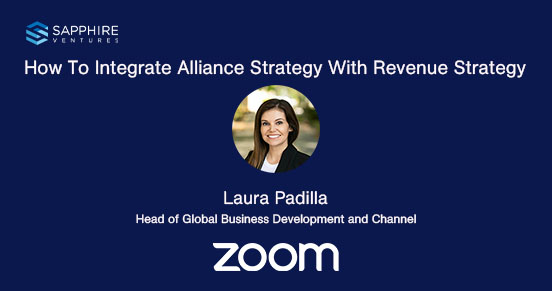Forming a strategic alliance with another company can help startups expand into new markets. While this may work in theory, partnerships sometimes fall apart due to misaligned revenue goals.
As a startup, before you invest too much time and resources into building alliances, it’s important to set goals based on product, revenue, or market penetration and growth, and gain buy-in from key stakeholders. The result of a well-integrated alliance and revenue strategy can enhance the value of your product, increase your marketing return, and accelerate pipeline and sales.

To find out how companies can ensure that their alliance strategy delivers on revenue goals, I spoke with Laura Padilla, head of global business development and channel at Zoom.
Laura has spent herentire career building strategic partnerships that drive revenue. She firmly believes that alliances must be built around strategic growth goals, which requires a thoughtful allocation of time and resources.
Based on my discussion with Laura, here are the necessary resources, measurements and objectives that every startup should consider when aligning their alliance strategies with revenue objectives.
Build an alliance strategy around your product
One would think the first step in aligning alliance with revenue strategy would be to focus on your sales organization, but Laura suggests centering partner relationships around your company’s product goals first. That starts with assessing how each alliance decision you make helps to support your product strategy and proliferate your product’s adoption.
Once your company and partners are aligned on where the product is headed, you can begin discussing shared use-cases and integrations with partners. For example, partnerships helped catalyze Zoom’s growth beyond its core video conferencing services to a complete unified communications as a service (UCaaS) offering. This also allowed the company to gain traction with new customers and markets.
Laura says that, ”Zoom Phone launched about a year ago, and the UCaaS community is highly entrenched with master agents—IT consultants who are experts in selling telephone communications and are well known for selling cloud PBX.”
The master agent networks were considered domain experts to the Zoom Phone’s product target audience, which made it clear that Zoom needed to build an alliance strategy with them. As a result, Zoom created a master agent program, which in 3-months grew to over 1,700 sub-agents who refer business to Zoom and receive ongoing commission payments based on referred leads. The quick success of the program is a direct result of making sure the product aligned with the channel.
When creating partner programs, product teams need to have a central role. Master agents are one example of aligning sales with product strategy. Another is Zoom’s focus on its platform and marketplace where it’s expanding its APIs and SDK’s to ISVs looking to integrate their services with Zoom and offer a new value-added service.
“Zoom’s partner team is working closely with product to find the right application integrations, build a platform story, and gain access into new verticals, customers and markets,” Laura says. In doing so, Zoom is able to expand use cases for its product, reaching new verticals such as healthcare and education. This is done through popular industry-specific external application integrations to Zoom’s products. For this to happen, the product team has to be willing to make the product accessible through APIs and SDKs. And the alliance team has to understand the product vision to identify the right partners to align with their vision.
Lastly, a company’s partnership should be assessed through two lenses when it comes to your product: does the partnership provide you with more access to your existing customer communities, or does it expand use-cases to help increase the addressable market for your product? If it doesn’t accomplish either goal then it most likely isn’t worth the invested resources.
Develop common goals and revenue objectives
Fighting internal and external battles can make partnerships unsuccessful. But creating common goals with your partners tied to revenue can help keep everyone aligned. Laura recommends quarterly reporting to keep track of these goals.
Identifying with your partner what those common goals are can be a challenge. Typically, Laura looks to achieve these four key characteristics in a partnership to best align on goals:
- Do you both have executive sponsorship? Determine if both parties will invest the necessary resources and time to make this a success.
- Are your product roadmaps aligned and committed to joint product integrations? Make sure what you are trying to build aligns to your shared objectives and that both of the companies involved product teams are committed to building a joint offering.
- Are you and your partner aligned on GTM strategies? Develop a mutual action plan on marketing, sales, and support.
- Do you deliver market leadership to other organizations? Are you and the partner benefiting by gaining access to a new area, or strengthening your respective market leadership?
“You’ll need clear guidance on how success is defined, and sometimes it could take years of working with a partner in order to develop confidence around long-term returns,” Laura says. And once you have defined mutual goals it will usually result in a successful partnership.
“When both companies have shared [revenue and product] goals, and when executives are aligned around that, they unblock your partnership team to do the work they need to do,” Laura says.
Hire the right people to nurture alliances
To combine partnerships with revenue goals, you’ll need to create a specialized team to marry those functions and get projects across the finish line. “Partnerships are all about building trust, and your team is the ambassador of that trust,” says Laura.
Here’s how to structure your alliance team:
- Hire an alliance manager. This person must be good at influencing all stakeholders in order to obtain buy-in for the alliance strategy.
- Involve the product team. They’ll execute on building integrations and achieving shared product goals with the partner company.
- Invest in partner sales personnel. Establish quotas or other revenue driven metrics for partner sales teams to help the company achieve the mutual revenue targets you define with your partners.
To drive a modern alliance strategy, hire people with a technical skill set to work closely with the product team. They’ll have to understand the ins and outs of your product and be connected to the design team to ensure customers engagements with technical integrations lead to the desired experience and conversion.
“We spend a lot of time [with the product team] on design. The hardest part is filling alliance roles…that can work with our design team on ways that help drive conversion. The best candidates were product managers in the past, and now they want to move into business development,” Laura says.
The alliance manager is also a critical position that’s tasked with driving shared goals between your company and the partner company. They will help establish cross-functionality, manage teams, and report to internal stakeholders on how the alliance strategy is doing against shared goals–both in terms of revenue and product roadmaps.
Measure your alliance strategy’s contribution to revenue
As the famous management thinker Peter Drucker’s said, “If you can’t measure it, you can’t improve it.”
With partnership strategy, a truer statement could not be made. It’s very easy for a company to invest in channels and partners without ever tracking whether they are driving real business value. To do so, Laura suggests identifying the right KPIs for the right partner type. If your partner is a reseller, a technology partner, or ISV focusing on building a new value added service to resell, you will want to track them differently and as follows below:
| Channel Type | Desired Outcome | KPIs |
| Traditional Partners: Resellers, VARs, GSIs | Drive net new pipeline, increase adoption in existing customers through relationships and purchasing. fulfillment | Number of qualified leads, new logos acquired, direct revenue generated |
| Technical partnerships requiring Integrations | Influence your company’s revenue rather than drive direct revenue. | Utilization of integration, co-marketing activity, number of top-of-funnel leads, decrease in cost per leads |
| Platform or developer integration partners | Build on top of your APIs and SDKs to bundle your solution into their offering. | API and SDK utilization, revenue generated from monetization of API’s |
The modern partnership is evolving
Technology is rapidly evolving. It’s changing how individuals and companies work, communicate, and reach constituents. And the modern partner ecosystem is changing too.
Business development leaders need to think outside of the box and reimagine what partnerships matter to their company. They will have to determine how to approach these partnerships in the right way, and how to monetize them.
The traditional VAR reseller model is evolving to be more focused on affiliates, referral partners, consultants, marketing partnerships, and platform partnerships. This requires a lot more strategy and thinking from leaders about how your partnership objectives are centered around product. You’ll need mutual goals and the right skills on your team to be successful.
If you can follow the framework outlined above you will be well on your way to developing innovative and rewarding partnerships that drive revenue.




